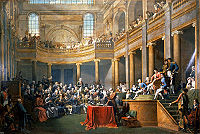- Collège-lycée Ampère
-
The Collège-lycée Ampère is a famous school located in the 2nd arrondissement of Lyon.
Contents
History
It was founded in 1519 by members of the Brotherhood of the Trinity. It was then known under the name of Collège de la Trinité. Under this name it was directed by the Jesuits from 1565 to 1762, then by the Oratorians until 1792.
During the French Revolution, the building was occupied by the troops of the National Convention and renamed École centrale. Napoléon Bonaparte, then First Consul, was proclaimed President of the Italian Republic during a gathering called the 'consulte de Lyon' in the high chapel of the school and with a consular order of vendémiaire 24 year XI (16 October 1802), the property was transformed into Lycée impérial. Under the Restoration, it was renamed Collège royal, until the French Revolution of 1848, when it became the Lycée de Lyon.
In 1888, he was named Lycée Ampère as tribute to the physician André-Marie Ampère.
It was the first mixed college in France. The poet Louise Labe, as well as Pernette du Guillet, studied in this school. This experience allowed commoners to access education. With their mentor, Maurice Scève, Louise Labe, daughter of tailpiece, Pernette and others, formed what was called the 'École de Lyon', a famous poets humanist association.[1]
Chapel of the Trinity
The chapel of the Trinity also called 'high chapel' was built in the College-lycée Ampère between 1617 and 1622 in the baroque style. En 1754, it was refurbished by the Lyon architect planner Jean-Antoine Morand. Classified monument historique in 1939, it was neglected and even served as the gym. Restored in the 1990s, it has nowadays regular classical music concerts.
Famous pupils and professors
- André-Marie Ampère
- Claude-François Menestrier
- François d'Aix de la Chaise
- Charles Baudelaire
- Edgar Quinet
- Édouard Herriot
- Édouard Daladier
- Robert Badinter
- André Latreille
- Albin Chalandon
- Michel Noir
- Bernard Pivot
- Jean Amadou
- Louis Maynard
- Marcel Maréchal
- Marc Riboud
- Max Meynier
- Jacques Martin
- Jean-Jacques Brochier
- Philippe Riboud
- Raymond Domenech
- Frédérique Barazer
References
- ^ Florence Weinberg, Longs désirs : Louise Labé, lyonnaise
- This article incorporates information from the revision as of 2009-05-27 of the equivalent article on the French Wikipedia.
External links
2nd arrondissement of Lyon Quarters Streets Cours Charlemagne · Passage de l'Argue · Rue Édouard-Herriot · Rue Émile-Zola · Rue de Brest · Rue de la Bourse · Rue de la Poulaillerie · Rue de la République · Rue des Archers · Rue des Marronniers · Rue Mercière · Rue Victor-HugoSquares Place Ampère · Place Antonin-Poncet · Place Bellecour · Place Carnot · Place de la République · Place des Célestins · Place des JacobinsPlaces of worship Basilique Saint-Martin d'Ainay · Chapelle de la Trinité · Église Saint-Bonaventure · Église Saint-Nizier · Grande synagogue de LyonOthers monuments Brasserie Georges · Catholic University of Lyon · Collège-lycée Ampère · Hôtel-Dieu de Lyon · La Sucrière · Musée de l'Imprimerie · Musée des Confluences · Palais de la Bourse · Patinoire Charlemagne · Prison Saint-PaulTransports Categories:- 2nd arrondissement of Lyon
- Buildings and structures in Lyon
- Education in Lyon
- Jesuit schools
- 1519 establishments
Wikimedia Foundation. 2010.


